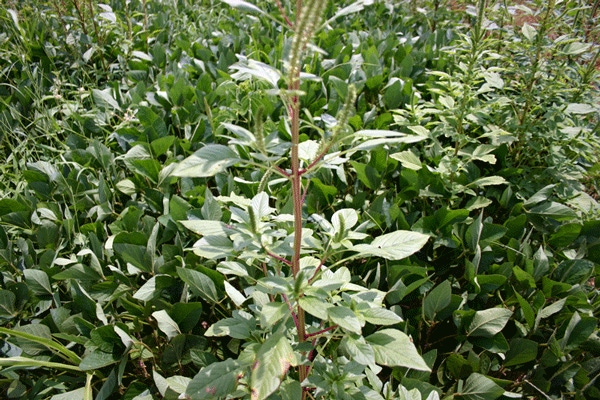February 3, 2011

Gone are the days when Alabama farmers saw glyphosate-resistant Palmer amaranth pigweed as a potential problem, restricted mostly to fields in neighboring states. It’s here, and it’s spreading, says Mike Patterson, Auburn University Extension weed scientist.
This past year, he says, it was confirmed in 20 counties in the state. In north Alabama, it has been found in Colbert, Lauderdale, Lawrence, Limestone, Madison, Ethowah, Calhoun and Cullman counties. In southeast Alabama, resistant Palmer pigweed has been confirmed in Barbour, Russell, Henry, Houston, Dale, Coffee, Covington, Pike and Geneva counties. It also has been found in the southwest counties of Baldwin, Escambia and Mobile.
There are critical points for growers to remember when attempting to control glyphosate-resistant Palmer pigweed in row crops, says Patterson. It’s important, he says, to plant into clean fields.
“Kill all weeds prior to planting, especially resistant weeds, using products that give residual control past the planting date,” he says. “And maintain constant residual control by using soil-active herbicides throughout the growing season.”
Growers should maintain post-harvest pigweed control, especially in early harvested crops like corn, by mowing, followed by 2,4-D or Gramoxone plus 2,4-D, he recommends. “Also, rotate crops and use herbicides with different modes of action in each crop,” says Patterson.
Turning specifically to controlling glyphosate-resistant Palmer amaranth in cotton production, growers must maintain residual control from burndown through layby, he says. Examples of such programs include the following:
• Diuron plus Gramoxone with crop oil concentrate (with Ignite if resistant horseweed) preplant foliar 15 days ahead of planting.
• Reflex (with Prowl, or diuron, or Staple) pre-emergence behind the planter. You must use Reflex with preplant foliar mix on fine-textured soils of the Tennessee Valley (and get one half inch of rain before planting cotton). If this is not activated by rain or irrigation before cotton emerges, then apply Staple before Palmer is 2 inches tall.
• Metolachlor (Dual Magnum, etc.) or Warrant with glyphosate (RRF cotton) or Ignite (Liberty-Link cotton) early postemergence (three to four-leaf cotton).
• Layby Pro or diuron (add 2 ounces of Valor) plus MSMA layby (these mixtures will kill a relatively large pigweed if the sprayer can cover it, but it must be kept off the cotton.
All of these residual herbicides must be activated by timely rainfall or overhead irrigation in order to work, says Patterson. These products will add between $30 (Reflex, Staple, Dual, Valor) and $40 (add Ignite burndown) per acre to your weed control costs above a system where two to three applications of glyphosate have worked in the past.
LibertyLink offers some relief
“If you’re growing LibertyLink cotton, that technology will give you some relief. The key is timing. Ignite will kill a Palmer pigweed at about 4 or 5 inches tall. For a weed that grows 2 inches per day, you can do the math.
For controlling glyphosate-resistant Palmer amaranth in soybeans, growers need to maintain residual weed control from burndown through row lapping, says Patterson. “Soybeans are more competitive than cotton, but we still have to depend on residuals, perhaps using a LibertyLink system,” he says.
Suggested weed programs for soybeans include the following:
• 2,4-D at 1 pint plus glyphosate or paraquat 15 days ahead of planting.
• Prefix, Valor or Boundary (pre-emergence) behind the planter (can add Prowl H2O).
• Firstrate (no ALS resistance), Warrant or Reflex (if ALS resistance) with glyphosate (RR soybean) or Ignite (LL soybean) postemergence.
• Flexstar or Cobra postemergence.
All of these herbicides, notes Patterson, must be activated by timely rainfall or overhead irrigation. Their use will add about $20 (Prefix, Valor, Boundary, Cobra) per acre to your weed control costs above a system where two to three applications of glyphosate have worked in the past. Growers should check tolerance before using Boundary as it contains metribuzin.
Corn, says Patterson, is a horse of a different color. “Some populations of Palmer — one in South Carolina — have been found that are resistant to atrazine. I don’t believe we have that in Alabama. Atrazine still works really well.”
Recommended weed control programs for corn include the following, in addition to maintaining residual weed control from burndown through row lapping:
• 2,4-D at 1 pint plus Gramoxone plus crop oil concentrate seven days ahead of planting.
• Dual, Micro-Tech, Outlook or Harness plus simazine (2 pints) pre-emergence.
• Atrazine (3 pints) plus crop oil concentrate or atrazine (3 pints) plus glyphosate (RR corn) postemergence. Atrazine (3 pints) plus Ignite (LL corn).
• 2,4-D plus Gramoxone post-harvest after mowing stalks to kill emerged pigweed.
Again, says Patterson, residual herbicides applied pre-emergence must be activated by timely rainfall or overhead irrigation to work.
For peanuts, in addition to maintaining residual weed control from burndown through row lapping, Patterson makes the following recommendations:
• Dual, Outlook, Prowl or Sonalan preplant incorporated.
• Valor or Strongarm pre-emergence.
• Cadre/Impose (no ALS resistance) or paraquat plus 2,4-DB postemergence.
• 2,4-DB, Cobra or UltraBlazer later postemergence.
Note: All the above residual herbicides must be activated by timely rainfall or overhead irrigation in order to work. These products will add around $20 (Prefix, Valor, Boundary, Cobra) per acre to your weed control costs above a system where two to three applications of glyphosate have worked in the past. Check variety tolerance before using Boundary (contains metribuzin).
Palmer amaranth identification
• No hairs on the plant — stem and leaf surfaces are smooth.
• Leaf petioles (leaf stalk) as long or longer than the leaf blade. Leaves occasionally have v-shaped variegation. Plants do not have spines.
• Flowering structure (spike) on large plants (6-8 feet) is one to two foot long.
• Each plant is either male or female. Male flowering structure feels soft and sheds pollen, female flowering structure feels prickly and produces seed.
About the Author(s)
You May Also Like




